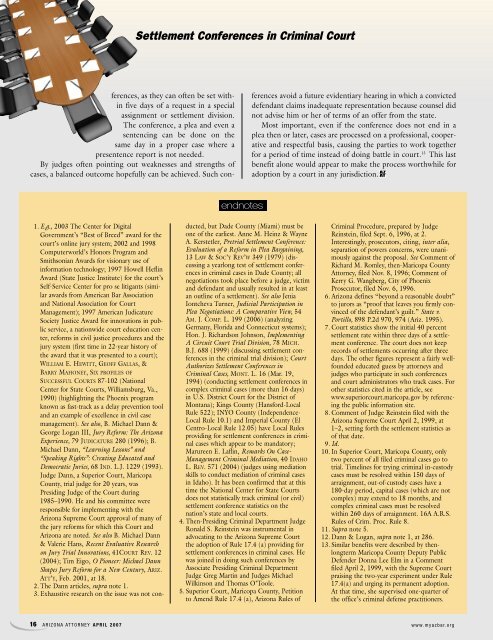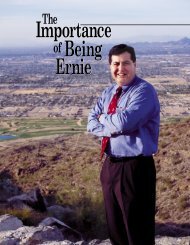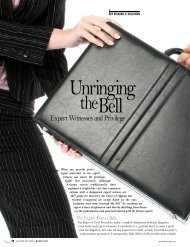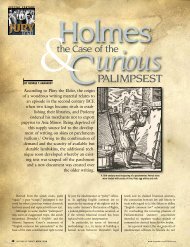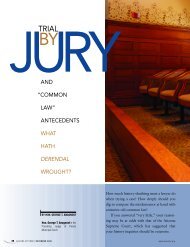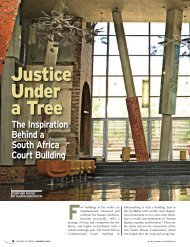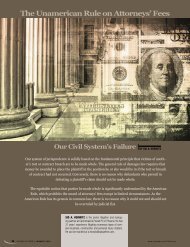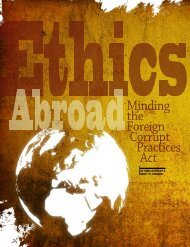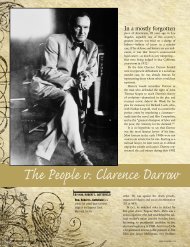Settlement Conferences in Criminal Court - Lawyers
Settlement Conferences in Criminal Court - Lawyers
Settlement Conferences in Criminal Court - Lawyers
- No tags were found...
You also want an ePaper? Increase the reach of your titles
YUMPU automatically turns print PDFs into web optimized ePapers that Google loves.
<strong>Settlement</strong> <strong>Conferences</strong> <strong>in</strong> Crim<strong>in</strong>al <strong>Court</strong>ferences, as they can often be set with<strong>in</strong>five days of a request <strong>in</strong> a specialassignment or settlement division.The conference, a plea and even asentenc<strong>in</strong>g can be done on thesame day <strong>in</strong> a proper case where apresentence report is not needed.By judges often po<strong>in</strong>t<strong>in</strong>g out weaknesses and strengths ofcases, a balanced outcome hopefully can be achieved. Such con-ferences avoid a future evidentiary hear<strong>in</strong>g <strong>in</strong> which a convicteddefendant claims <strong>in</strong>adequate representation because counsel didnot advise him or her of terms of an offer from the state.Most important, even if the conference does not end <strong>in</strong> aplea then or later, cases are processed on a professional, cooperativeand respectful basis, caus<strong>in</strong>g the parties to work togetherfor a period of time <strong>in</strong>stead of do<strong>in</strong>g battle <strong>in</strong> court. 13 This lastbenefit alone would appear to make the process worthwhile foradoption by a court <strong>in</strong> any jurisdiction. AZATendnotes1. E.g., 2003 The Center for DigitalGovernment’s “Best of Breed” award for thecourt’s onl<strong>in</strong>e jury system; 2002 and 1998Computerworld’s Honors Program andSmithsonian Awards for visionary use of<strong>in</strong>formation technology; 1997 Howell Hefl<strong>in</strong>Award (State Justice Institute) for the court’sSelf-Service Center for pro se litigants (similarawards from American Bar Associationand National Association for <strong>Court</strong>Management); 1997 American JudicatureSociety Justice Award for <strong>in</strong>novations <strong>in</strong> publicservice, a nationwide court education center,reforms <strong>in</strong> civil justice procedures and thejury system (first time <strong>in</strong> 22-year history ofthe award that it was presented to a court);WILLIAM E. HEWITT, GEOFF GALLAS, &BARRY MAHONEY, SIX PROFILES OFSUCCESSFUL COURTS 87-102 (NationalCenter for State <strong>Court</strong>s, Williamsburg, Va.,1990) (highlight<strong>in</strong>g the Phoenix programknown as fast-track as a delay prevention tooland an example of excellence <strong>in</strong> civil casemanagement). See also, B. Michael Dann &George Logan III, Jury Reform: The ArizonaExperience, 79 JUDICATURE 280 (1996); B.Michael Dann, “Learn<strong>in</strong>g Lessons” and“Speak<strong>in</strong>g Rights”: Creat<strong>in</strong>g Educated andDemocratic Juries, 68 IND. L.J. 1229 (1993).Judge Dann, a Superior <strong>Court</strong>, MaricopaCounty, trial judge for 20 years, wasPresid<strong>in</strong>g Judge of the <strong>Court</strong> dur<strong>in</strong>g1985–1990. He and his committee wereresponsible for implement<strong>in</strong>g with theArizona Supreme <strong>Court</strong> approval of many ofthe jury reforms for which this <strong>Court</strong> andArizona are noted. See also B. Michael Dann& Valerie Hans, Recent Evaluative Researchon Jury Trial Innovations, 41COURT REV. 12(2004); Tim Eigo, O Pioneer: Michael DannShapes Jury Reform for a New Century, ARIZ.ATT’Y, Feb. 2001, at 18.2. The Dann articles, supra note 1.3. Exhaustive research on the issue was not conducted,but Dade County (Miami) must beone of the earliest. Anne M. He<strong>in</strong>z & WayneA. Kerstetler, Pretrial <strong>Settlement</strong> Conference:Evaluation of a Reform <strong>in</strong> Plea Barga<strong>in</strong><strong>in</strong>g,13 LAW & SOC’Y REV’W 349 (1979) (discuss<strong>in</strong>ga yearlong test of settlement conferences<strong>in</strong> crim<strong>in</strong>al cases <strong>in</strong> Dade County; allnegotiations took place before a judge, victimand defendant and usually resulted <strong>in</strong> at leastan outl<strong>in</strong>e of a settlement). See also JeniaIontcheva Turner, Judicial Participation <strong>in</strong>Plea Negotiations: A Comparative View, 54AM. J. COMP. L. 199 (2006) (analyz<strong>in</strong>gGermany, Florida and Connecticut systems);Hon. J. Richardson Johnson, Implement<strong>in</strong>gA Circuit <strong>Court</strong> Trial Division, 78 MICH.B.J. 688 (1999) (discuss<strong>in</strong>g settlement conferences<strong>in</strong> the crim<strong>in</strong>al trial division); <strong>Court</strong>Authorizes <strong>Settlement</strong> <strong>Conferences</strong> <strong>in</strong>Crim<strong>in</strong>al Cases, MONT. L. 16 (Mar. 19,1994) (conduct<strong>in</strong>g settlement conferences <strong>in</strong>complex crim<strong>in</strong>al cases (more than 16 days)<strong>in</strong> U.S. District <strong>Court</strong> for the District ofMontana); K<strong>in</strong>gs County (Hansford-LocalRule 522); INYO County (Independence-Local Rule 10.1) and Imperial County (ElCentro-Local Rule 12.05) have Local Rulesprovid<strong>in</strong>g for settlement conferences <strong>in</strong> crim<strong>in</strong>alcases which appear to be mandatory;Marureen E. Lafl<strong>in</strong>, Remarks On Case-Management Crim<strong>in</strong>al Mediation, 40 IDAHOL. REV. 571 (2004) (judges us<strong>in</strong>g mediationskills to conduct mediation of crim<strong>in</strong>al cases<strong>in</strong> Idaho). It has been confirmed that at thistime the National Center for State <strong>Court</strong>sdoes not statistically track crim<strong>in</strong>al (or civil)settlement conference statistics on thenation’s state and local courts.4. Then-Presid<strong>in</strong>g Crim<strong>in</strong>al Department JudgeRonald S. Re<strong>in</strong>ste<strong>in</strong> was <strong>in</strong>strumental <strong>in</strong>advocat<strong>in</strong>g to the Arizona Supreme <strong>Court</strong>the adoption of Rule 17.4 (a) provid<strong>in</strong>g forsettlement conferences <strong>in</strong> crim<strong>in</strong>al cases. Hewas jo<strong>in</strong>ed <strong>in</strong> do<strong>in</strong>g such conferences byAssociate Presid<strong>in</strong>g Crim<strong>in</strong>al DepartmentJudge Greg Mart<strong>in</strong> and Judges MichaelWilk<strong>in</strong>son and Thomas O’Toole.5. Superior <strong>Court</strong>, Maricopa County, Petitionto Amend Rule 17.4 (a), Arizona Rules ofCrim<strong>in</strong>al Procedure, prepared by JudgeRe<strong>in</strong>ste<strong>in</strong>, filed Sept. 6, 1996, at 2.Interest<strong>in</strong>gly, prosecutors, cit<strong>in</strong>g, <strong>in</strong>ter alia,separation of powers concerns, were unanimouslyaga<strong>in</strong>st the proposal. See Comment ofRichard M. Romley, then-Maricopa CountyAttorney, filed Nov. 8, 1996; Comment ofKerry G. Wangberg, City of PhoenixProsecutor, filed Nov. 6, 1996.6. Arizona def<strong>in</strong>es “beyond a reasonable doubt”to jurors as “proof that leaves you firmly conv<strong>in</strong>cedof the defendant’s guilt.” State v.Portillo, 898 P.2d 970, 974 (Ariz. 1995).7. <strong>Court</strong> statistics show the <strong>in</strong>itial 40 percentsettlement rate with<strong>in</strong> three days of a settlementconference. The court does not keeprecords of settlements occurr<strong>in</strong>g after threedays. The other figures represent a fairly wellfoundededucated guess by attorneys andjudges who participate <strong>in</strong> such conferencesand court adm<strong>in</strong>istrators who track cases. Forother statistics cited <strong>in</strong> the article, seewww.superiorcourt.maricopa.gov by referenc<strong>in</strong>gthe public <strong>in</strong>formation site.8. Comment of Judge Re<strong>in</strong>ste<strong>in</strong> filed with theArizona Supreme <strong>Court</strong> April 2, 1999, at1–2, sett<strong>in</strong>g forth the settlement statistics asof that date.9. Id.10. In Superior <strong>Court</strong>, Maricopa County, onlytwo percent of all filed crim<strong>in</strong>al cases go totrial. Timel<strong>in</strong>es for try<strong>in</strong>g crim<strong>in</strong>al <strong>in</strong>-custodycases must be resolved with<strong>in</strong> 150 days ofarraignment, out-of-custody cases have a180-day period, capital cases (which are notcomplex) may extend to 18 months, andcomplex crim<strong>in</strong>al cases must be resolvedwith<strong>in</strong> 260 days of arraignment. 16A A.R.S.Rules of Crim. Proc. Rule 8.11. Supra note 5.12. Dann & Logan, supra note 1, at 286.13. Similar benefits were described by thenlongtermMaricopa County Deputy PublicDefender Donna Lee Elm <strong>in</strong> a Commentfiled April 2, 1999, with the Supreme <strong>Court</strong>prais<strong>in</strong>g the two-year experiment under Rule17.4(a) and urg<strong>in</strong>g its permanent adoption.At that time, she supervised one-quarter ofthe office’s crim<strong>in</strong>al defense practitioners.16 ARIZONA ATTORNEY APRIL 2007www.myazbar.org


